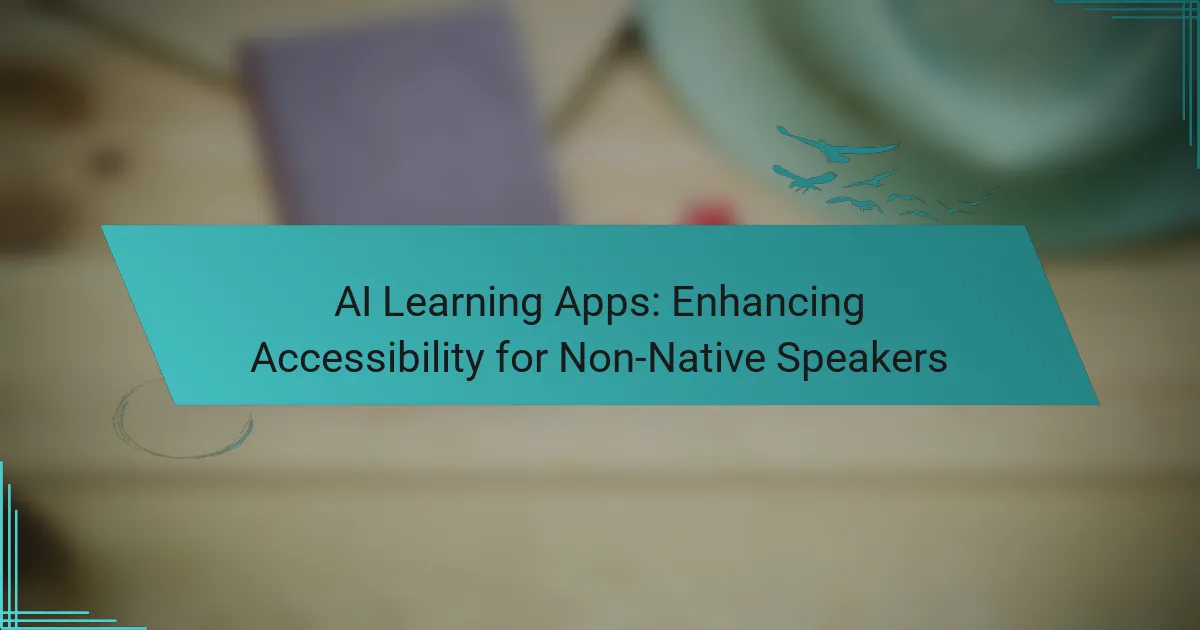AI learning apps are revolutionizing language acquisition for non-native speakers by offering personalized educational experiences tailored to individual needs. Utilizing advanced algorithms, these applications provide immediate feedback and interactive practice, making language learning more accessible and effective than ever before.

How Do AI Learning Apps Improve Language Skills for Non-Native Speakers?
AI learning apps enhance language skills for non-native speakers by providing tailored educational experiences that adapt to individual needs. These applications leverage advanced algorithms to offer personalized content, immediate feedback, and opportunities for interactive practice, making language acquisition more accessible and effective.
Personalized learning experiences
Personalized learning experiences in AI language apps allow users to progress at their own pace. These apps assess a learner’s current proficiency and adapt lessons accordingly, focusing on areas that require improvement. For instance, if a user struggles with verb conjugations, the app may provide additional exercises specifically targeting that skill.
Many apps also utilize user data to recommend content that aligns with personal interests, making learning more engaging. This customization can include selecting topics related to hobbies or professional fields, which helps maintain motivation and relevance in the learning process.
Real-time feedback mechanisms
Real-time feedback mechanisms are crucial for effective language learning, as they provide instant corrections and suggestions. AI-powered apps can analyze spoken or written language and offer immediate insights, helping users understand their mistakes and learn from them. This immediate response can significantly enhance retention and comprehension.
For example, when a user practices speaking, the app may highlight pronunciation errors and suggest improvements. This type of feedback is often more effective than traditional methods, as it allows learners to adjust their approach on the spot, reinforcing correct usage and building confidence.
Interactive language practice
Interactive language practice is a key feature of AI learning apps, enabling users to engage in conversations with virtual partners or chatbots. This practice simulates real-life interactions, which is essential for developing conversational skills. Users can practice speaking, listening, and comprehension in a low-pressure environment.
Additionally, many apps incorporate gamified elements, such as quizzes and challenges, to make learning fun and competitive. This approach not only enhances engagement but also encourages regular practice, which is vital for language retention. By participating in interactive scenarios, learners can apply their skills in context, further solidifying their understanding.

Which AI Learning Apps Are Most Effective for Non-Native Speakers?
Several AI learning apps stand out for their effectiveness in helping non-native speakers improve their language skills. These applications leverage interactive features and personalized learning paths to enhance accessibility and engagement.
Duolingo
Duolingo is a popular choice among non-native speakers due to its gamified approach to language learning. Users can practice vocabulary, grammar, and pronunciation through engaging exercises that adapt to their skill level.
The app offers a wide range of languages and is free to use, with optional premium features. Its bite-sized lessons make it easy to fit learning into a busy schedule, allowing users to practice for just a few minutes each day.
Babbel
Babbel focuses on conversational skills, making it particularly useful for non-native speakers looking to communicate effectively. The app provides structured lessons that emphasize real-life dialogues and practical vocabulary.
While Babbel requires a subscription, its content is designed by language experts, ensuring high-quality material. Users can expect to see progress in their speaking and listening abilities within a few weeks of consistent practice.
Busuu
Busuu combines language learning with social interaction, allowing non-native speakers to practice with native speakers through its community features. This peer feedback can significantly enhance speaking and writing skills.
The app offers personalized study plans and tracks progress, making it suitable for learners at various levels. While some features are free, a premium subscription unlocks additional resources and offline access, providing flexibility for users on the go.

What Features Should Non-Native Speakers Look for in AI Learning Apps?
Non-native speakers should prioritize features that enhance language comprehension and usability. Key elements include speech recognition technology, multilingual support, and gamification elements, which collectively improve the learning experience and accessibility.
Speech recognition technology
Speech recognition technology allows users to practice pronunciation and receive instant feedback. This feature is crucial for non-native speakers, as it helps them improve their speaking skills by identifying pronunciation errors and suggesting corrections. Look for apps that offer real-time analysis and scoring to track progress.
When evaluating apps, consider those that support various accents and dialects, as this can enhance the learning experience. For example, an app that recognizes both American and British English pronunciations can cater to a wider audience.
Multilingual support
Multilingual support is essential for non-native speakers, as it enables users to learn in their native language while gradually transitioning to the target language. Apps that offer content in multiple languages can help users understand complex concepts without feeling overwhelmed.
Choose apps that provide a seamless switch between languages, allowing learners to access explanations, vocabulary, and grammar rules in their preferred language. This feature can significantly reduce frustration and improve retention of new information.
Gamification elements
Gamification elements, such as points, badges, and leaderboards, can make language learning more engaging for non-native speakers. These features motivate users to practice regularly and track their progress in a fun way. Look for apps that incorporate challenges and rewards to maintain interest over time.
Additionally, consider apps that offer social features, allowing users to compete or collaborate with friends. This social interaction can enhance motivation and create a supportive learning environment, making the process more enjoyable and effective.

How Do AI Learning Apps Enhance Accessibility for Non-Native Speakers?
AI learning apps significantly improve accessibility for non-native speakers by offering tailored language learning experiences. These applications leverage advanced technology to provide resources that are easily accessible, affordable, and adaptable to various learning environments.
Availability of diverse languages
AI learning apps often support a wide range of languages, making it easier for non-native speakers to find resources in their target language. Many platforms include popular languages such as Spanish, Mandarin, and French, as well as less commonly taught languages, thus catering to diverse linguistic needs.
This variety allows learners to choose the language they wish to study without being limited by traditional educational offerings. Additionally, many apps provide localized content, which helps users understand cultural nuances and context better.
Affordability compared to traditional methods
AI learning apps are generally more affordable than traditional language courses, which can be costly and require significant time commitments. Many apps operate on a subscription model, with monthly fees often ranging from a few dollars to around twenty dollars, making them accessible to a broader audience.
Some platforms even offer free versions with essential features, allowing users to start learning without any financial investment. This affordability empowers more individuals to pursue language learning, regardless of their economic background.
Offline learning options
Many AI learning apps provide offline capabilities, enabling users to download lessons and practice without needing an internet connection. This feature is particularly beneficial for non-native speakers who may not always have reliable access to the internet.
Offline learning options allow users to study at their convenience, whether during commutes or in remote areas. This flexibility can lead to more consistent practice and improved language retention over time.

What Are the Challenges of Using AI Learning Apps for Language Learning?
AI learning apps can enhance language acquisition but also present several challenges for users, particularly non-native speakers. These challenges include limited cultural context and a heavy reliance on technology, which can impact the effectiveness of the learning experience.
Limited cultural context
AI learning apps often lack the cultural nuances that are essential for mastering a language. While they can provide vocabulary and grammar rules, they may not adequately convey idiomatic expressions or cultural references that are crucial for real-world communication.
For instance, a phrase that works in one culture may not have the same meaning or impact in another. Users might find themselves confused or misinterpreting conversations without the cultural context that traditional learning methods often provide.
Dependence on technology
Relying heavily on AI learning apps can lead to a diminished ability to engage in spontaneous conversations. Users may become accustomed to structured lessons and automated feedback, which can hinder their ability to think and respond quickly in real-life situations.
Moreover, technical issues such as connectivity problems or app malfunctions can disrupt learning. It’s essential for users to balance app usage with traditional methods, such as speaking with native speakers or participating in language exchange programs, to develop a well-rounded skill set.
